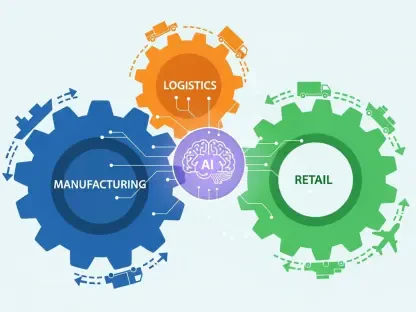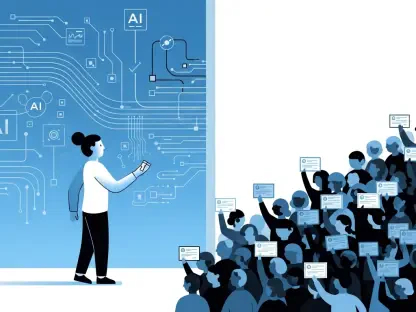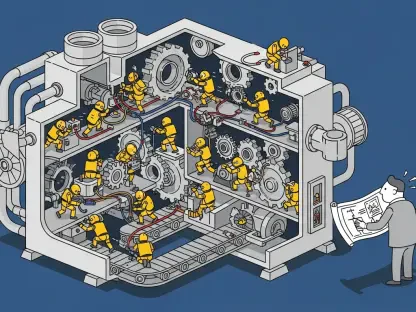In an era where artificial intelligence (AI) is reshaping every facet of the creative landscape, a critical challenge has emerged for industry leaders: how to harness this powerful technology without falling into the trap of producing uninspired, generic content often referred to as “slop.” This pressing concern took center stage at a recent event hosted by the Gerety Awards at VCCP London, where a gathering of creative minds tackled the dual nature of AI as both a potential pitfall and a transformative tool. The discussion, moderated by Nicola Kemp of Creativebrief, brought together influential voices from across the sector to explore strategies for ensuring that AI amplifies human ingenuity rather than dilutes it. Their insights shed light on a growing consensus that technology, while capable of streamlining processes, must be guided by human judgment to create work that resonates on a cultural and emotional level. This event underscored the urgency of redefining AI’s role in creativity to avoid mediocrity and champion originality.
Navigating the Risks of AI-Driven Mediocrity
The conversation at the Gerety Awards event revealed a shared concern among creative leaders about AI’s tendency to generate unremarkable output when left unchecked. Panelists, including voices from VCCP, Snap Inc., Not Just Any, and Gravity Road, pointed out that while AI can accelerate ideation and production, it often lacks the nuanced understanding of cultural context that human creators bring to the table. This can result in content that feels formulaic or disconnected from its intended audience. The risk of “slop”—subpar, uninspired work—becomes especially pronounced when AI is used as a shortcut rather than a tool for enhancement. A key takeaway was the importance of setting clear intentions when integrating AI into workflows. Without deliberate oversight, the technology can replicate existing patterns of mediocrity rather than push boundaries. The panel emphasized that creative leaders must prioritize discernment to ensure that AI serves as a catalyst for innovation, not a crutch that undermines the depth and authenticity of their output.
Adding to this perspective, the discussion highlighted that the issue of uninspired content is not new to the industry—it predates AI by decades. However, the advent of advanced algorithms has amplified the scale at which such content can be produced, making the need for vigilance even more critical. The panelists urged a proactive stance, suggesting that AI should be employed to test and refine concepts rather than dictate final outcomes. This approach requires a balance of technological efficiency with human insight to elevate ideas beyond the ordinary. Moreover, there was a call to avoid using past failures as a blueprint for future work, instead focusing on how AI can break cycles of sameness. By fostering a mindset of experimentation and critical evaluation, creative leaders can steer clear of the pitfalls that lead to generic results. This strategic use of AI, grounded in purpose and taste, offers a pathway to maintain the integrity of creative endeavors while leveraging the benefits of modern tools.
Harnessing AI as a Tool for Innovation
Beyond the risks, the Gerety Awards event also illuminated AI’s potential to revolutionize creativity when paired with human oversight. Panelists underscored that the true value of AI lies in its ability to enhance, rather than replace, the creative process. For instance, AI can handle repetitive tasks, analyze vast datasets, and generate initial concepts, freeing up human creators to focus on refining and imbuing work with emotional resonance. Mark Eaves from Gravity Road emphasized the role of wisdom in navigating the influx of digital tools, noting that cultural sensitivity and experienced judgment are what transform raw AI output into impactful content. This synergy between technology and human intuition was seen as essential for producing work that stands out in a crowded market. The discussion painted a picture of AI as a collaborative partner—one that can spark new ideas and streamline execution, provided it is guided by a clear vision and a deep understanding of audience needs.
Equally compelling was the notion that AI holds the power to democratize creativity by lowering barriers to entry and enabling broader participation. The panelists highlighted how this technology can empower emerging talent and diverse voices to contribute to the creative landscape, provided it is wielded with intention. However, they cautioned that democratization should not come at the expense of quality. Lucía Ongay, Co-Founder of the Gerety Awards, captured this sentiment by noting that while AI transforms how creativity is executed, it does not change why creativity matters. The risk of sameness remains a central concern, but so does the opportunity to inject originality and humanity into every project. By using AI to explore uncharted perspectives and challenge conventional thinking, creative leaders can ensure that the technology becomes a force for groundbreaking work. This forward-thinking approach positions AI as a means to amplify diversity in thought and output, ultimately enriching the industry as a whole.
Building a Future of Meaningful Creativity
Reflecting on the insights shared during the Gerety Awards event, it became evident that the industry has reached a pivotal moment in its relationship with AI. The panelists collectively reinforced the idea that technology should amplify human creativity, not dictate its direction. Their discussions served as a reminder that the success of AI in creative fields hinges on the ability to balance efficiency with cultural relevance, ensuring that outputs are not just functional but deeply meaningful. The event also celebrated the achievements of London’s award winners, whose work stood as a testament to the power of human-driven innovation even amidst technological advancements. Looking back, the consensus among participants was one of cautious optimism, recognizing AI’s potential to break new ground when paired with intentionality and expertise.
Moving forward, creative leaders must commit to strategies that prevent the pitfalls of generic content while embracing AI’s capabilities. A practical next step involves establishing frameworks for AI integration that prioritize human oversight at every stage of the creative process. Investing in training and education to build digital literacy among teams can also ensure that tools are used with purpose and precision. Additionally, fostering a culture of experimentation—where AI is leveraged to explore bold ideas rather than replicate safe ones—can help redefine industry standards. Collaboration across sectors, bringing together technologists and creatives, offers another avenue to refine how AI is applied. By focusing on these actionable measures, the creative industry can transform AI from a potential source of “slop” into a powerful ally for originality and impact, ensuring that future work continues to inspire and connect on a profound level.









